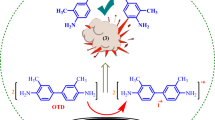Abstract
The anodic oxidation of N-anions of diacylimides which are acidic enough to be deprotonated by relatively weak bases in protic solvents was investigated with respect to the electrode kinetics and preparative aspects. All imide anions are oxidized in a one-electron step to the respective imide radicals. Of the imides investigated, two were cyclic carboxylic imides (succinimide and phthalimide) three were sulphonyl imides (di-p-toluene and di-benzene sulphimide, dimethane sulphimide) and one was a mixed carboxylate-sulphonate imide (saccharate). The imide radicals produced by anodic oxidation of the dicarboxylate imides do not couple to form a hydrazine derivative but induce solvent oxidation by H-abstraction. The disulphonyl imides couple to unstable hydrazine derivatives although H-abstraction occurs to more than 80%. Only the anodic coupling of the N-anion of imido-disulphonic acid to hydrazine tetrasulphonate discovered by Grinstead [3] can be performed with good selectivity and current and mass yields. The optimum conditions for this reaction are determined in order to show that it may serve in the future as one step in a new hydrazine process.
Similar content being viewed by others
References
R. Bauer and H. WendtAngew. Chem. Internat. Edn. 17 (1978) 202.
Idem, ibid 17 (1978) 370.
R. Ohme and A. Zubeck,Zeitschrift f. Chemie 8 (1968) 41.
K. Othmer, ‘Encyclopedia of Chemical Technology’ 2nd edn (edited by E. A. Parolla) Interscience, New York (1966) Vol. II, p. 164.
R. R. Grinstead,J. Inorg. Nucl. Chem. 4 (1957) 287.
R. Bauer and H. Wendt,J. Electroanalyt. Chem. 80 (1977) 395.
A. R. Butler,J. Chem. Soc. Perkin Trans. 2 (1974) 1239.
C. R. Guerillot,Compt. rend. 240 (1955) 1107.
J. T. Edward and K. A. Terry,J. Chem. Soc. (1957) 3527.
H. F. Walton and A. E. Martell,J. Amer. Chem. Soc. 74 (1952) 5745.
G. Dauphin and A. Kergonard,Bull. Soc. Chim. 3 (1961) 486.
G. J. Doyh and N. Davidson,J. Amer. Chem. Soc. 71 (1949) 3491.
B. Zerne and M. L. Benderibid 83 (1961) 2267.
P. S. Skell, J. C. Day and J. P. Slanga,Angew. Chem. 90 (1978) 546.
T. Curtins and F. Lorenzen,J. prakt. Chem. 58 (1898) 160.
A. A. Witte,Rec. trav. chim. 51 (1931) 299.
F. Lober,Angew. Chem. 64 (1952) 65.
M. Katz, P. Reimenschneider and H. Wendt,Electrochim. Acta 17 (1972) 1595.
E. Schmidt and S. Stucki,Ber. Bunsenges. Phys. Chem. 77 (1973) 913.
S. Gilman,J. Phys. Chem. 43 (1969) 425.
F. Beck and H. Guthke,Chem. Ing. Techn. 41 (1969) 943.
R. Dworak and H. Wendt,Ber. Bunsenges. Phys. Chem. 80 (1976) 77.
Idem, Chem. Ing. Techn. 49 (1977) 349.
Y. Ito and Y. Yoshino,Nippon Kagaku Kaishi (1975) 1160.
‘Inorganic Synthesis’ (edited by W. C. Fernelins) Vol. 2 McGraw Hill, New York (1946) p. 180.
J. M. Kolthoff,J. Amer. Chem. Soc. 46 (1924) 2009.
Author information
Authors and Affiliations
Additional information
For parts I and II see [1] and [2].
Rights and permissions
About this article
Cite this article
Ali, Z., Bauer, R., Schön, W. et al. Anodic oxidation of N-anions. III. Anodic oxidation of the N-anions of diacylimides: A search for a new electrochemical synthesis of hydrazine. J Appl Electrochem 10, 97–107 (1980). https://doi.org/10.1007/BF00937344
Received:
Issue Date:
DOI: https://doi.org/10.1007/BF00937344



